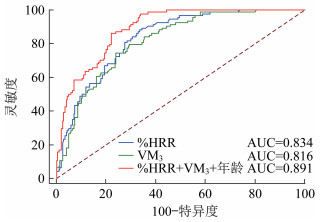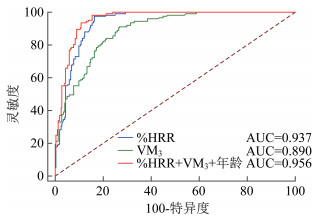Diagnostic Criteria and Value of Multiple-index Joint Diagnosis of Exercise Intensity in Obese Children and Adolescents
-
摘要:目的 建立多指标联合诊断肥胖儿童青少年运动强度的标准,为诊断肥胖儿童青少年运动强度提供方法学参考。方法 招募160名10~17岁肥胖儿童青少年(训练集120人,验证集40人),测试3~7 km/h自由走、跑运动的代谢当量(MET)、心率储备百分比(% HRR)和综合矢量计数(VM3);采用Logistic回归建立多指标联合诊断模型,以多指标联合预测概率值(P3METs和P6METs)绘制ROC曲线,以最大约登指数确定适宜切点;通过ROC曲线下面积评价诊断价值,通过准确率和加权Kappa值检验准确性和一致性。结果 多指标联合诊断模型为Logist(P3METs)=10.666-9.760×10-2×% HRR-1.035×10-3×VM3-0.290×年龄;Logist(P6METs)=-15.337+0.127×% HRR+6.316×10-4×VM3+0.176×年龄。P3METs诊断运动强度的切点是0.315,ROC曲线下面积为0.891;P6METs诊断运动强度的切点是0.248,ROC曲线下面积为0.956。多指标联合的诊断准确率为79.62%,加权Kappa值为0.686。结论 多指标联合诊断模型可用于诊断肥胖儿童青少年运动强度,具有较高的诊断价值。诊断标准是低强度P3METs>0.315,中等强度P3METs≤0.315且P6METs < 0.248,高强度P6METs≥0.248。Abstract:Objective To establish a multi-index method for the diagnosis of exercise intensity, and provide a methodological reference for accurately diagnosing exercise intensity of obese children and adolescents.Methods 160 obese children and adolescents aged 10~17 were randomly divided into training group (n=120) and validation group (n=40). The METs, %HRR and vector magnitudes (VM3) were measured for all participants during free walking and running at 3~7 km/h. Logistic regression was used to establish the multi-index joint diagnosis model, and the ROC curve was conducted with the prediction probability values (P3METs and P6METs), and the cut-off point of intensity was determined by the maximum Youden index. The area under the ROC curve was evaluated for diagnostic value, accuracy and weighted Kappa values were tested for accuracy and consistency.Results The 3METs multi-index joint diagnosis model was Logist(P3METs)=10.666-9.760×10-2×%HRR-1.035×10-3×VM3-0.290×Age, while the 6METs was Logist(P6METs)=-15.34+0.127×%HRR+6.316×10-4×VM3+0.176×Age. The cut-off point of 3METs for P3METswas 0.315, and the area under curve of ROC was 0.891.The cut-off point of 6METs for P6METswas 0.248, and the area under curve of ROC was 0.956. The accuracy of multiple-index joint diagosis was 79.62%, and the weighted Kappa value was 0.686.Conclusion Multiple-index joint diagnosis model can be used to diagnose the exercise intensity of obese children and adolescents, which has high diagnostic value.The diagnostic criteria of light-intensity was P3METs>0.315, moderate-intensity P3METs ≤ 0.315 and P6METs < 0.248, and high-intensity P6METs ≥ 0.248.
-
肥胖是21世纪全球严重的公共卫生问题之一,儿童青少年肥胖及其带来的健康问题日趋严重,而身体活动不足是其重要诱因。世界卫生组织发布的《关于身体活动和久坐行为指南》(Guidelines on Physical Activity and Sedentary Behaviour)及我国发布的《中国儿童青少年身体活动指南》均指出,儿童青少年应每天至少保持60 min的中高强度身体活动,每周至少保持3 d的高强度身体活动[1-3];中高强度和高强度身体活动在降低儿童青少年肥胖发生风险、促进身体健康等方面的作用日益受到关注[4-6]。准确的运动强度诊断标准是指导儿童青少年达到身体活动推荐量的前提。运动强度的诊断以代谢当量(Metabolic Equivalent,MET)为金标准,《儿童青少年身体活动汇编》(A Youth Compendium of Physical Activities:Activity Codes and Metabolic Intensities)[7]归纳整理了儿童青少年常见运动项目的MET值,为诊断正常体质量儿童青少年运动强度提供了参考。但是,肥胖儿童青少年的MET具有特殊性,其单位体质量的静息能耗低于正常体质量儿童青少年[8-10],因此正常体质量儿童青少年常见运动项目的MET值可能并不适用于肥胖儿童青少年。
运动强度的准确诊断方法是运动健康促进领域研究的重要内容,国内外一些学者[11-14]也尝试建立了包括正常体质量儿童青少年在内的不同人群单一指标(运动加速度计计数和心率)诊断运动强度的切点值,但这些切点值在诊断肥胖儿童青少年运动强度时存在较大差异。对于同一批超重/肥胖儿童青少年,不同单一指标诊断标准确定的中高强度运动时间的误差范围甚至能达到4~66 min/d[15]。总之,当前肥胖儿童青少年运动强度诊断标准的方法学研究相对滞后,不利于肥胖儿童青少年开展科学有效的运动锻炼,也不利于运动健康促进研究的深入。
多指标联合诊断是疾病诊断中的常用方法,能提高单一指标的诊断准确性,具有诊断价值高、诊断结果准确的优势,在医学领域中有较为广泛的研究应用[16-18]。然而,多指标联合诊断在运动科学领域的应用研究相对较少,其能否应用于诊断肥胖儿童青少年运动强度及提高单一指标的诊断准确性尚不清楚。为此,本文在建立单一指标运动强度诊断标准的基础上,尝试将多指标联合诊断的方法应用于诊断肥胖儿童青少年运动强度,为提高其诊断准确性、制定肥胖儿童青少年运动策略和实施干预方案提供方法学参考。
1. 研究对象与方法
1.1 研究对象
招募160名10~17岁肥胖儿童青少年,其中10~12岁儿童60人(男、女各30人),13~17岁青少年100人(男、女各50人)。根据性别和年龄进行分层随机分组,由计算机产生随机序列并按照3∶1的比例随机划分为用于建立运动强度诊断标准的训练集(男、女各60人)和用于检验诊断方法准确性的验证集(男、女各20人)。纳入标准:以身体质量指数(Body Mass Index,BMI)为筛查指标,筛查标准参照2018年卫健委发布实施的《学龄儿童青少年超重与肥胖筛查》;排除病理性肥胖或伴有严重并发症的儿童青少年。
1.2 测试方法
1.2.1 基本信息
采集受试者的性别、年龄、身高、体质量、BMI等基本信息。
1.2.2 能量消耗测试
选择德国产Cortex Meta Max 3B便携式气体代谢分析仪进行静息测试和运动测试,获取静息耗氧量(mL·kg-1·min-1)和运动耗氧量(mL·kg-1·min-1)。测试中同步佩戴Polar心率带记录安静心率和运动负荷心率;同步佩戴ActiGraph GT3X+三轴运动加速度计(ActiGraph,Pensacola,FL,USA)记录综合矢量计数(Vector Mangiture,VM3)。GT3X+的采样频率为30 Hz,采样间隔60 s,佩戴位置为右侧腋窝中线与髂脊水平线的交界处。
① 静息测试:要求受试者在测试前24 h内禁止饮用咖啡或酒精类饮品。测试在餐后2 h,室温25℃~27℃的环境下进行,受试者静坐15 min后佩戴测试仪器[8-9, 19],随后静卧15 min。②运动测试:选择3 km·h-1(散步)、4 km·h-1(慢走)、5 km·h-1(正常步行)、6 km·h-1(慢跑)、7 km·h-1(慢跑)的自由走、跑,每个速度持续5 min,中间无间隔。测试场地为10 m×10 m的方形运动场地,每5 m放置1个标志物,受试者在标志物外侧行走或跑步;以提示音控制速度,提示音每隔6 s(3 km·h-1)、4.5 s(4 km·h-1)、3.6 s(5 km·h-1)、3 s(6 km·h-1)、2.57 s(7 km·h-1)出现1次,当提示音出现时要求受试者到达下一个标志物,测试过程由研究人员领走或领跑。在测试过程中,受试者达到以下标准之一时终止测试:心率达到90%最大心率;呼吸商 > 1.10;主观疲劳感觉 > 17。
1.3 数据指标提取方法
选用静息测试11~15 min的静息耗氧量(mL·kg-1·min-1)、安静心率(次·min-1)和每个运动测试4~5 min的运动耗氧量(mL·kg-1·min-1)、负荷心率(次·min-1)、VM3(counts·min-1)为最终数据。运动强度MET值=运动耗氧量/静息耗氧量;心率储备(Heart Rate Reserve)百分比(%HRR)=(负荷心率-安静心率)/(最大心率-安静心率)×100%,最大心率=220-年龄。
1.4 统计分析
计量资料采用均值±标准差的形式表示,计量资料组间比较采用独立样本t检验。①建立多指标联合诊断模型,并根据模型计算多指标联合诊断运动强度的预测概率值。将运动强度划分为低强度(METs<3)、中等强度(3≤METs<6)和高强度(METs≥6)[2];以运动强度为因变量,%HRR、VM3、年龄、性别、身高、体质量和BMI为自变量,采用逐步回归筛选自变量,Logistic回归建立多指标联合诊断模型。以方差膨胀因子(Variance Inflation Factor,VIF)检验模型的自变量之间的多重共线性,VIF越大表明共线性越严重,0 < VIF < 10表示不存在多重共线性,VIF≥10表示存在严重多重共线性。②比较多指标联合与单一指标的诊断价值。绘制3METs和6METs的单一指标和多指标联合预测概率值的受试者工作特征曲线(Receiver Operating Characteristic,ROC),通过ROC曲线下面积(Area Under Curve,AUC)确定诊断价值:AUC越接近于1,诊断价值越大;AUC<0.5表示无诊断价值,0.5≤AUC<0.7表示诊断价值较低,0.7≤AUC<0.85表示诊断价值中等,0.85≤AUC<0.95表示诊断价值较高,AUC≥0.95表示诊断价值极高;采用Delong等[20]的方法检验不同AUC是否存在显著差异,以“ΔAUC”表示不同AUC比较的差值。③确定单一指标和多指标联合预测概率值的适宜切点。以最大约登指数确定3METs和6METs的单一指标和多指标联合预测概率值的适宜切点,最大约登指数=敏感度+特异度-1。④检验诊断结果的准确性与一致性。诊断结果与实测结果的差异性检验采用McNemar's test,准确性的检验采用准确率、精确率和召回率3个指标;一致性检验采用加权Kappa值。一致性程度的标准是:强(0.81~1.00)、较强(0.61~0.80)、中等(0.41~0.60)、一般(0.21~0.40)。采用RStudio软件进行统计分析,MedCale 19.0软件绘制ROC曲线,P < 0.05表示差异具有统计学意义。
2. 研究结果
2.1 基本情况
训练集男、女各60人,验证集男、女各20人,训练集和验证集受试者基线值未见显著差异(P > 0.05),基本情况如表 1所示。
表 1 受试者基本情况Table 1. Basic information of the participants类别 训练集(n=120) 验证集(n=40) 总体(n=160) 年龄/岁 13.4±2.4 13.2±2.3 13.3±2.3 身高/cm 164.2±10.1 164.9±11.0 164.4±10.3 体质量/kg 78.8±17.0 76.3±19.6 78.2±17.7 BMI/(kg·m-2) 28.9±3.9 27.6±3.9 28.6±3.93 2.2 静息及运动测试的指标特征
肥胖儿童青少年静息耗氧量约为4.35 mL·kg-1·min-1,高于正常成年人3.50 mL·kg-1·min-1的约定值,而低于正常体质量儿童青少年(约6.28~6.48 mL·kg-1·min-1)[21]。运动耗氧量随自由走、跑速度的增加而呈增加的趋势,3 km·h-1运动属于低强度运动,4 km·h-1和5 km·h-1运动属于中等强度运动,6 km·h-1和7 km·h-1运动属于高强度运动。静息及运动测试结果如表 2所示。
表 2 静息及运动测试结果Table 2. The main outcomes of resting and activity measurements测试项目 耗氧量/(mL·kg-1·min-1) MET 心率/(次·min-1) %HRR VM3/(counts·min-1) 静息状态 4.35±0.83 1.00 83±12 — — 3 km/h运动 12.09±2.09 2.82±0.67 122±15 31.57±9.73 2 945±704 4 km/h运动 13.99±2.58 3.31±0.70 1 285±15 36.67±9.68 3 844±810 5 km/h运动 17.38±2.62 4.10±0.80 141±16 46.28±10.50 4 877±1 013 6 km/h运动 27.23±4.84 6.44±1.44 172±16 71.93±12.92 6 998±1 789 7 km/h运动 30.91±4.67 7.21±1.37 182±15 79.87±11.45 8 039±2 022 注:—表示无对应值。 2.3 构建运动强度的多指标联合诊断模型
以Logistic回归分别构建3METs和6METs的多指标联合诊断模型,用于计算多指标联合预测概率值。结果显示,逐步回归共筛选出VM3、%HRR、年龄等3个自变量。以运动强度是否<3METs,将运动强度划分为二分类变量(<3METs赋值为1,≥3METs赋值为0),构建的3METs多指标联合诊断模型Logist(P3METs)=10.666-9.760×10-2×%HRR-1.035×10-3×VM3-0.290×年龄。以运动强度是否≥6METs,将运动强度划分为二分类变量(≥6METs赋值为1,<6METs赋值为0),构建的6METs多指标联合诊断模型Logist(P6METs)=-15.337+0.127×%HRR+6.316×10-4×VM3+0.176×年龄(表 3)。VM3、%HRR、年龄与运动强度的关系显著(P < 0.05),所有自变量的VIF值均小于10,表明自变量间不存在多重共线性,模型均成立。
表 3 运动强度多指标联合诊断模型Table 3. Multi-index joint diagnosis model for exercise intensity诊断模型 变量 回归系数 标准误 Z P VIF 3METs 常量 10.666 1.534 6.954 < 0.000 1 — %HRR -9.760×10-2 0.018 -5.387 < 0.000 1 1.03 VM3 -1.035×10-3 0.002×10-1 -5.102 < 0.001 1.11 年龄 -0.290 0.078 -3.787 0.000 2 1.09 6METs 常量 -15.337 2.043 -7.506 < 0.000 1 — %HRR 0.127 1.706×10-2 7.465 < 0.000 1 1.03 VM3 6.316×10-4 1.296×10-4 4.873 < 0.000 1 1.04 年龄 0.176 8.504×10-2 2.069 0.085 1.06 注:—表示无对应值。 2.4 单一指标和多指标联合评价运动强度的诊断切点
分别以单一指标VM3、%HRR和多指标联合预测概率值(P3METs和P6METs)绘制3METs和6METs的ROC曲线。3METs的ROC曲线结果显示,P3METs的AUC为0.891,诊断价值较高(表 4),显著高于VM3(ΔAUC=0.075,P=0.000 1)和%HRR(ΔAUC=0.056,P=0.000 9)(表 5、图 1);VM3和%HRR的AUC分别是0.816和0.834,诊断价值中等。由于3METs是中高强度运动的切点,P3METs的AUC高于单一指标%HRR和VM3的AUC,表明多指标联合诊断中高强度运动的诊断价值高于单一指标。6METs的ROC曲线结果显示,P6METs的AUC为0.956,诊断价值极高(表 4),显著高于%HRR(ΔAUC=0.019,P=0.005 4)和VM3(ΔAUC=0.066,P < 0.000 1);%HRR和VM3具有较高的诊断价值,AUC分别是0.890、0.937(图 2、表 5)。
表 4 运动强度的单一指标和多指标联合诊断的适宜切点Table 4. The cut-off points of single and multi-index joint diagnosis of exercise intensity诊断模型 变量 AUC 标准误 P 95% CI 灵敏度 特异度 最大约登指数 适宜切点 上限 下限 3METs %HRR 0.834 0.023 < 0.000 1 0.787 0.875 89.36 65.50 0.549 41.66 VM3 0.816 0.025 < 0.000 1 0.767 0.859 74.47 76.00 0.505 3 687 P3METs 0.891 0.018 < 0.000 1 0.849 0.924 86.17 78.00 0.642 0.315 6METs %HRR 0.937 0.013 < 0.000 1 0.905 0.961 97.64 83.50 0.811 63.05 VM3 0.890 0.017 < 0.000 1 0.851 0.922 91.34 73.00 0.643 5 247 P6METs 0.956 0.011 < 0.000 1 0.927 0.975 98.43 96.39 0.829 0.248 表 5 单一指标和多指标联合的诊断价值比较Table 5. Comparison of diagnostic value of the single index and multi-index joint诊断模型 比较方案 ΔAUC 标准误 95%CI Z P 上限 下限 3METs a vs b 0.018 0.030 -0.041 0.077 0.604 0.545 7 a vs c 0.056 0.017 0.023 0.090 3.297 0.000 9 b vs c 0.075 0.019 0.037 0.112 3.913 0.000 1 6METs a vs b 0.047 0.019 0.011 0.083 2.544 0.011 0 a vs c 0.019 0.007 0.006 0.032 2.781 0.005 4 b vs c 0.066 0.014 0.038 0.094 4.569 < 0.000 1 注:a表示%HRR,b表示VM3,c表示“%HRR+VM3+年龄”,ΔAUC表示不同ROC曲线比较的AUC差值。 最大约登指数确定的%HRR、VM3、P3METs的3METs适宜切点为41.66%、3 687 counts·min-1和0.315(图 1、表 4);%HRR、VM3、P6METs的6METs适宜切点为63.05%、5 247 counts·min-1、0.248(图 2、表 4)。
2.5 单一指标和多指标联合诊断运动强度的准确性与一致性检验
准确率是诊断正确的样本个数与总体个数的比值,代表诊断方法的整体准确性[22]。本文结果显示,多指标联合的预测准确率比VM3高约15%,比%HRR高约5%,表明多指标联合诊断运动强度的总体准确性高于单一指标(表 6)。
表 6 不同方法诊断准确性与一致性检验结果Table 6. Diagnostic accuracy and consistency of the test in the single index and multi-index joint diagnosis诊断方法 准确率/% 中高强度 高强度 χ2检验的P 加权Kappa 精确率/% 召回率/% 精确率/% 召回率/% VM3 64.81 92.3 83.08 65.15 91.49 0.001 0.471 %HRR 74.69 100 77.69 84.31 91.49 0.001 0.626 %HRR+VM3+年龄 79.62 96.52 85.38 86.27 93.62 0.003 0.686 精确率是指正确诊断为阳性的样本个数占全部预测为阳性的样本个数的比例,代表诊断方法能否查准;召回率是指正确诊断为阳性的样本个数占实际为阳性的样本个数的比例,代表诊断方法能否查全[22]。本文研究结果(表 6)显示:3种方法诊断中高强度运动的精确率均在90%以上;多指标联合召回率最高,达到85.38%,提示对于中高强度运动,单一指标和多指标联合均能查准,但多指标联合诊断更全。3种方法诊断高强度运动的召回率均在90%以上;多指标联合的精确率最高,达到86.27%,表明对于高强度运动,单一指标和多指标联合均能查全,但多指标联合诊断更准确。一致性检验结果也表明,多指标联合的诊断结果与实测结果的一致性更高(加权Kappa=0.686)。
3. 讨论与展望
3.1 讨论
运动促进健康依赖于一定的运动强度,中高强度运动特别是高强度运动对肥胖儿童青少年健康促进的有益作用已被证实[23-24]。生理指标(心率)以及运动信号(VM3)常用于监控日常身体活动[25-27],在一定范围内与机体的耗氧量存在高度相关,因此,心率和运动加速度计计数可用于评估运动强度[28]。在实际应用中,为排除个体间安静心率不同的影响,通常采用心率变化率、最大心率百分比和%HRR等指标评估运动强度[29]。朱琳等[30]采集10~14岁正常体质量儿童青少年实验室跑台走、跑运动测试的心率变化率,并通过ROC曲线确定了正常体质量儿童青少年中等强度和高强度运动的诊断切点,具有较高的诊断价值(AUC均在0.85以上)。运动加速度计是身体活动研究领域重要的监测设备,该设备可记录运动过程中的运动加速度,经过几十年的发展,运动加速度计已从最初的单轴运动加速度计发展成三轴运动加速度计[31]。运动加速度计采集的原始加速度值不能直接评价运动强度,通常将原始运动加速度值转化为运动加速度计数点。学者早期建立的运动强度诊断切点主要以单轴(垂直轴)运动加速度计计数点为主;与垂直轴相比,VM3是综合垂直轴、额状轴、矢状轴的计数值,能较为真实地反映人体日常生活状态下的身体活动情况,因此,VM3在身体活动研究中应用更为广泛[27, 31-32]。
本文研究发现,生理指标%HRR和运动信号VM3对于诊断肥胖儿童青少年的运动强度具有较高的诊断价值,并且%HRR、年龄和VM3能够用于构建肥胖儿童青少年运动强度的多指标联合诊断模型。通过比较单一指标和多指标联合的诊断价值发现,单一指标VM3和%HRR诊断3METs的切点的AUC均未超过0.85(%HRR:0.834,VM3:0.816),诊断价值为中等,而多指标联合诊断3METs的切点的AUC为0.891,较为显著地提高了诊断价值。由于3METs的切点是中高强度的诊断切点,而中高强度又是目前运动健康促进领域重点关注的运动强度,因此,多指标联合能够提高中高强度的诊断价值,且具有较高的应用价值。
为进一步确定多指标联合是否能够准确诊断肥胖儿童青少年的运动强度及其应用价值,采用验证集数据检验其准确性,发现VM3和%HRR诊断中高强度的整体准确率分别为64.81%和74.69%。多指标联合诊断的整体准确率比VM3高15%,比%HRR高5%,表明多指标联合诊断的方法能提高单一指标诊断运动强度的准确性。与本文研究结果类似,Chowdhury等[33]也发现,心率结合其他生理指标建立的多指标联合机器学习模型能够提高运动强度的诊断准确性。此外,从实际应用的角度看,评价运动强度诊断方法的应用价值时,还应充分考虑对不同运动强度能否查准和查全。从确保肥胖儿童青少年达到“每天60 min中高强度运动、每周至少3 d高强度运动”的身体活动推荐量的角度看,本文对多指标联合诊断中高强度运动和高强度运动的精确率和召回率进行比较,发现单一指标和多指标联合诊断中高强度运动的精确率均在90%以上,多指标联合的召回率比%HRR高约8%;多指标联合诊断高强度运动的精确率和召回率均高于单一指标,表明多指标联合更能够准确、全面地诊断肥胖儿童青少年的运动强度,从而能更有效地确保肥胖儿童青少年身体活动的安全性和有效性。
3.2 展望
本文构建了生理指标%HRR、运动信号VM3诊断运动强度的适宜切点,为肥胖儿童青少年运动强度的多指标联合诊断提供了相对准确、便捷的方法学参考;以%HRR、VM3和年龄构建了运动强度多指标联合诊断模型,并证实该模型获得的多指标联合预测概率值在肥胖儿童青少年运动强度诊断中的可行性以及应用价值。多指标联合诊断运动强度的准确率接近80%,未来可通过丰富指标多样性,增加如步频、主观疲劳、皮肤电反应、呼吸等指标,进一步提升诊断的准确性[34]。最新研究[35-36]发现,以运动加速度计的原始加速度值构建运动强度诊断模型的准确性较高,未来可纳入原始加速度值,并结合其他复杂算法,进一步提高诊断肥胖儿童青少年运动强度的准确性。此外,未来可进一步开发相关网页计算器、手机App等,拓展多指标联合诊断运动强度的应用途径。
4. 结论
生理和运动信号组成的多指标联合诊断模型可作为肥胖儿童青少年运动强度的诊断标准,多指标联合能提高运动强度的诊断准确性。单一指标诊断运动强度的标准:低强度为%HRR<41.66%,VM3<3 687 counts·min-1;中等强度为41.66%≤%HRR<63.05%,3 687 counts·min-1≤VM3<5 247 counts·min-1;高强度为%HRR≥63.05%,VM3≥5 247 counts·min-1。多指标联合诊断运动强度的标准:低强度为P3METs>0.315,中等强度为P3METs≤0.315且P6METs<0.248,高强度为P6METs≥0.248。
作者贡献声明:刘景新:设计论文框架,分析数据,撰写论文;朱琳:提出论文主题,确定论文框架,修改论文;徐佶:调研分析文献,协助设计论文框架,修改论文;苏煜:协助招募受试者,采集数据,修改论文;孙越鹏:协助招募受试者,采集数据;廖晶:协助采集数据,校对论文;胡水:分析文献,修改论文;刘晓光:分析文献,修改论文。 -
表 1 受试者基本情况
Table 1 Basic information of the participants
类别 训练集(n=120) 验证集(n=40) 总体(n=160) 年龄/岁 13.4±2.4 13.2±2.3 13.3±2.3 身高/cm 164.2±10.1 164.9±11.0 164.4±10.3 体质量/kg 78.8±17.0 76.3±19.6 78.2±17.7 BMI/(kg·m-2) 28.9±3.9 27.6±3.9 28.6±3.93 表 2 静息及运动测试结果
Table 2 The main outcomes of resting and activity measurements
测试项目 耗氧量/(mL·kg-1·min-1) MET 心率/(次·min-1) %HRR VM3/(counts·min-1) 静息状态 4.35±0.83 1.00 83±12 — — 3 km/h运动 12.09±2.09 2.82±0.67 122±15 31.57±9.73 2 945±704 4 km/h运动 13.99±2.58 3.31±0.70 1 285±15 36.67±9.68 3 844±810 5 km/h运动 17.38±2.62 4.10±0.80 141±16 46.28±10.50 4 877±1 013 6 km/h运动 27.23±4.84 6.44±1.44 172±16 71.93±12.92 6 998±1 789 7 km/h运动 30.91±4.67 7.21±1.37 182±15 79.87±11.45 8 039±2 022 注:—表示无对应值。 表 3 运动强度多指标联合诊断模型
Table 3 Multi-index joint diagnosis model for exercise intensity
诊断模型 变量 回归系数 标准误 Z P VIF 3METs 常量 10.666 1.534 6.954 < 0.000 1 — %HRR -9.760×10-2 0.018 -5.387 < 0.000 1 1.03 VM3 -1.035×10-3 0.002×10-1 -5.102 < 0.001 1.11 年龄 -0.290 0.078 -3.787 0.000 2 1.09 6METs 常量 -15.337 2.043 -7.506 < 0.000 1 — %HRR 0.127 1.706×10-2 7.465 < 0.000 1 1.03 VM3 6.316×10-4 1.296×10-4 4.873 < 0.000 1 1.04 年龄 0.176 8.504×10-2 2.069 0.085 1.06 注:—表示无对应值。 表 4 运动强度的单一指标和多指标联合诊断的适宜切点
Table 4 The cut-off points of single and multi-index joint diagnosis of exercise intensity
诊断模型 变量 AUC 标准误 P 95% CI 灵敏度 特异度 最大约登指数 适宜切点 上限 下限 3METs %HRR 0.834 0.023 < 0.000 1 0.787 0.875 89.36 65.50 0.549 41.66 VM3 0.816 0.025 < 0.000 1 0.767 0.859 74.47 76.00 0.505 3 687 P3METs 0.891 0.018 < 0.000 1 0.849 0.924 86.17 78.00 0.642 0.315 6METs %HRR 0.937 0.013 < 0.000 1 0.905 0.961 97.64 83.50 0.811 63.05 VM3 0.890 0.017 < 0.000 1 0.851 0.922 91.34 73.00 0.643 5 247 P6METs 0.956 0.011 < 0.000 1 0.927 0.975 98.43 96.39 0.829 0.248 表 5 单一指标和多指标联合的诊断价值比较
Table 5 Comparison of diagnostic value of the single index and multi-index joint
诊断模型 比较方案 ΔAUC 标准误 95%CI Z P 上限 下限 3METs a vs b 0.018 0.030 -0.041 0.077 0.604 0.545 7 a vs c 0.056 0.017 0.023 0.090 3.297 0.000 9 b vs c 0.075 0.019 0.037 0.112 3.913 0.000 1 6METs a vs b 0.047 0.019 0.011 0.083 2.544 0.011 0 a vs c 0.019 0.007 0.006 0.032 2.781 0.005 4 b vs c 0.066 0.014 0.038 0.094 4.569 < 0.000 1 注:a表示%HRR,b表示VM3,c表示“%HRR+VM3+年龄”,ΔAUC表示不同ROC曲线比较的AUC差值。 表 6 不同方法诊断准确性与一致性检验结果
Table 6 Diagnostic accuracy and consistency of the test in the single index and multi-index joint diagnosis
诊断方法 准确率/% 中高强度 高强度 χ2检验的P 加权Kappa 精确率/% 召回率/% 精确率/% 召回率/% VM3 64.81 92.3 83.08 65.15 91.49 0.001 0.471 %HRR 74.69 100 77.69 84.31 91.49 0.001 0.626 %HRR+VM3+年龄 79.62 96.52 85.38 86.27 93.62 0.003 0.686 -
[1] Centers for Disease Control and Prevention. Physical activity guidelines for school-aged children and adolescents[EB/OL]. [2021-01-29]. https://www.cdc.gov/healthyschools/physicalactivity/guidelines.htm
[2] 张云婷, 马生霞, 陈畅, 等. 中国儿童青少年身体活动指南[J]. 中国循证儿科杂志, 2017, 12(6): 401-409 doi: 10.3969/j.issn.1673-5501.2017.06.001 [3] BULL F C, AL-ANSARI S S, BIDDLE S, et al. World Health Organization 2020 guidelines on physical activity and sedentary behaviour[J]. Br J Sports Med, 2020, 54(24): 1451-1462 doi: 10.1136/bjsports-2020-102955
[4] JÚDICE P B, HETHERINGTON-RAUTH M, NORTHST ONE K, et al. Changes in physical activity and sedentary patterns on cardiometabolic outcomes in the transition to adolescence: International children's accelerometry database 2.0[J]. J Pediatr, 2020, 225: 166-173, e1 doi: 10.1016/j.jpeds.2020.06.018
[5] CHEN P J, WANG D F, SHEN H B, et al. Physical activity and health in Chinese children and adolescents: Expert consensus statement(2020)[J]. Br J Sports Med, 2020, 54(22): 1321-1331 doi: 10.1136/bjsports-2020-102261
[6] SKREDE T, STEENE-JOHANNESSEN J, ANDERSSEN S A, et al. The prospective association between objectively measured sedentary time, moderate-to-vigorous physical activity and cardiometabolic risk factors in youth: A systematic review and meta-analysis[J]. Obes Rev, 2019, 20(1): 55-74 doi: 10.1111/obr.12758
[7] BUTTE N F, WATSON K B, RIDLEY K, et al. A youth compendium of physical activities: Activity codes and metabolic intensities[J]. Med Sci Sports Exerc, 2018, 50(2): 246-256 doi: 10.1249/MSS.0000000000001430
[8] WHITE D A, STAGGS V S, WILLIAMS V, et al. Handheld indirect calorimetry as a clinical tool for measuring resting energy expenditure in children with and without obesity[J]. Child Obes, 2019, 15(4): 280-287 doi: 10.1089/chi.2018.0332
[9] ZHANG L, CHEN R, LI R, et al. Evaluating the predictive factors of resting energy expenditure and validating predictive equations for Chinese obese children[J]. World J Pediatr, 2018, 14(2): 160-167 doi: 10.1007/s12519-017-0111-9
[10] 朱琳, 陈佩杰. 肥胖青少年静息能量代谢研究[J]. 中国学校卫生, 2011, 32(10): 1222-1224 https://www.cnki.com.cn/Article/CJFDTOTAL-XIWS201110024.htm [11] GÁBA A, DYGRÝN J, MITÁŠ J, et al. Effect of accelerometer cut-off points on the recommended level of physical activity for obesity prevention in children[J]. PLoS One, 2016, 11(10): e0164282 doi: 10.1371/journal.pone.0164282
[12] HOWE C A, CLEVENGER K A, LESLIE R E, et al. Comparison of accelerometer-based cut-points for children's physical activity: Counts vs. steps[J]. Children, 2018, 5(8): 105 doi: 10.3390/children5080105
[13] TROST S G, LOPRINZI P D, MOORE R, et al. Comparison of accelerometer cut points for predicting activity intensity in youth[J]. Med Sci Sports Exerc, 2011, 43(7): 1360-1368 doi: 10.1249/MSS.0b013e318206476e
[14] 朱琳, 陈佩杰. 应用ROC曲线确定活动计数在青春期少年运动强度诊断中的最佳临界值[J]. 体育科学, 2012, 32(11): 70-75 doi: 10.3969/j.issn.1000-677X.2012.11.009 [15] MIGUELES J H, CADENAS-SANCHEZ C, TUDORLOCKE C, et al. Comparability of published cut-points for the assessment of physical activity: Implications for data harmonization[J]. Scand J Med Sci Sports, 2019, 29(4): 566-574 http://www.onacademic.com/detail/journal_1000041628946899_e073.html
[16] MAO N N, LIU Y T, CHEN K W, et al. Combinations of multiple neuroimaging markers using logistic regression for auxiliary diagnosis of alzheimer disease and mild cognitive impairment[J]. Neurodegener Dis, 2018, 18(2-3): 91-106 doi: 10.1159/000487801
[17] 陈雪晴, 吴智聪, 冯俊慧. 多指标联合模型对儿童早期EB病毒感染的诊断价值[J]. 热带医学杂志, 2019, 19(10): 1237-1240, 1327 doi: 10.3969/j.issn.1672-3619.2019.10.012 [18] 仲崇明. Logistic回归在多指标联合诊断肺癌中的应用[J]. 中国卫生统计, 2016, 33(6): 1045-1046 https://www.cnki.com.cn/Article/CJFDTOTAL-ZGWT201606038.htm [19] COMPHER C, FRANKENFIELD D, KEIM N, et al. Best practice methods to apply to measurement of resting metabolic rate in adults: A systematic review[J]. J Am Diet Assoc, 2006, 106(6): 881-903 doi: 10.1016/j.jada.2006.02.009
[20] DELONG E R, DELONG D M, CLARKE-PEARSON D L. Comparing the areas under two or more correlated receiver operating characteristic curves: A nonparametric approach[J]. Biometrics, 1988, 44(3): 837-845 doi: 10.2307/2531595
[21] 朱琳. 11~14岁青春期少年常见体力活动能耗测量的方法学研究[D]. 上海: 上海体育学院, 2012: 20-21 [22] EUSEBI P. Diagnostic accuracy measures[J]. Cerebrovasc Dis, 2013, 36(4): 267-272 doi: 10.1159/000353863
[23] 朱琳, 刘景新, 于洋, 等. 高强度间歇训练对超重和肥胖青少年减脂效应的研究: Meta分析[J]. 广州体育学院学报, 2020, 40(1): 96-101 https://www.cnki.com.cn/Article/CJFDTOTAL-GZTX202001022.htm [24] LIU J X, ZHU L, SU Y. Comparative effectiveness of highintensity interval training and moderate-intensity continuous training for cardiometabolic risk factors and cardiorespiratory fitness in childhood obesity: A metaanalysis of randomized controlled trials[J]. Front Physiol, 2020, 11: 214 doi: 10.3389/fphys.2020.00214
[25] HÄNGGI J M, PHILLIPS L R S, ROWLANDS A V. Validation of the GT3X ActiGraph in children and comparison with the GT1M ActiGraph[J]. J Sci Med Sport, 2013, 16(1): 40-44 doi: 10.1016/j.jsams.2012.05.012
[26] AINSWORTH B, CAHALIN L, BUMAN M, et al. The current state of physical activity assessment tools[J]. Prog Cardiovasc Dis, 2015, 57(4): 387-395 doi: 10.1016/j.pcad.2014.10.005
[27] GASTIN P B, CAYZER C, DWYER D, et al. Validity of the ActiGraph GT3X+ and BodyMedia SenseWear Armband to estimate energy expenditure during physical activity and sport[J]. J Sci Med Sport, 2018, 21(3): 291-295 doi: 10.1016/j.jsams.2017.07.022
[28] 孙建刚, 刘阳, 任波, 等. 身体活动客观测量方法的比较与选择[J]. 体育科研, 2021, 42(1): 69-76 https://www.cnki.com.cn/Article/CJFDTOTAL-TYKA202101011.htm [29] LUAN X, TIAN X Y, ZHANG H X, et al. Exercise as a prescription for patients with various diseases[J]. J Sport Health Sci, 2019, 8(5): 422-441 doi: 10.1016/j.jshs.2019.04.002
[30] 朱琳, 陈佩杰. 运用受试者工作特征曲线对不同运动强度的心率变化率最佳临界点的研究[J]. 中国运动医学杂志, 2014, 33(1): 17-21, 33 https://www.cnki.com.cn/Article/CJFDTOTAL-YDYX201401003.htm [31] 刘阳. 基于加速度计的身体活动测量研究前沿[J]. 北京体育大学学报, 2016, 39(8): 66-73 https://www.cnki.com.cn/Article/CJFDTOTAL-BJTD201608012.htm [32] MIGUELES J H, CADENAS-SANCHEZ C, EKELUND U, et al. Accelerometer data collection and processing criteria to assess physical activity and other outcomes: A systematic review and practical considerations[J]. Sports Med, 2017, 47(9): 1821-1845 doi: 10.1007/s40279-017-0716-0
[33] CHOWDHURY A K, TJONDRONEGORO D, CHANDRAN V, et al. Prediction of relative physical activity intensity using multimodal sensing of physiological data[J]. Sensors, 2019, 19(20): 4509 doi: 10.3390/s19204509
[34] 秦正积, 沈毅, 崔晓莉, 等. logistic回归在疾病多指标联合诊断中的应用[J]. 中国卫生统计, 2014, 31(1): 116-117 https://www.cnki.com.cn/Article/CJFDTOTAL-ZGWT201401036.htm [35] NARAYANAN A, DESAI F, STEWART T, et al. Application of raw accelerometer data and machinelearning techniques to characterize human movement behavior: A systematic scoping review[J]. J Phys Act Health, 2020, 17(3): 360-383 doi: 10.1123/jpah.2019-0088
[36] FARRAHI V, NIEMELÄ M, TJURIN P, et al. Evaluating and enhancing the generalization performance of machine learning models for physical activity intensity prediction from raw acceleration data[J]. IEEE J Biomed Health Inform, 2020, 24(1): 27-38 doi: 10.1109/JBHI.2019.2917565




 下载:
下载:

